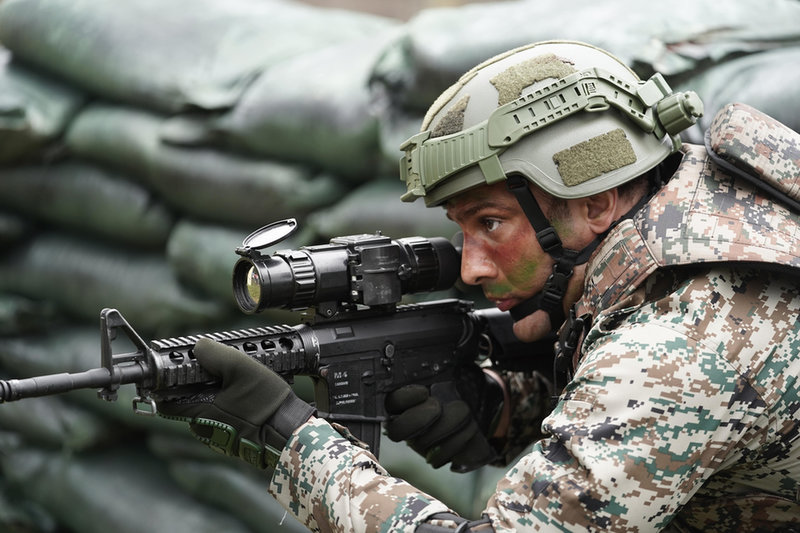Feature
Future forces: redefining soldier protection
In the race of military modernisation, numerous aerospace, defence, and security companies are competing to enhance soldier safety and performance. Harry McNeil reports.

Pioneering soldier safety: MKU amongst other industry players is redefining ballistic protection. Credit: MKU
In a dynamic era of military advancements, industry players emerge as vanguards in the evolution of integrated soldier wearables. Breaking new ground, the sector is combining smart textiles with ballistic materials to enhance modern soldiers' survivability and changing their capabilities on the ever-changing battlefield.
In the swiftly evolving landscape of global defence, pursuing military modernisation is not merely a strategic imperative; it is a continuous race to equip soldiers with the most advanced and adaptable tools. It is to this task that industry has set itself in an attempt to meet the requirements of a discerning customer base.
Trends in military modernisation and soldier PPE development
GlobalData's Thematic Research on Soldier Modernization (2023) highlights that the modern soldier's survivability is as crucial as diversifying their roles and capabilities. Survivability now encompasses counter-UAS (C-UAS/UGV) technology, thermal signature management, respiratory protection, and various other forms of protective equipment.
Tristan Sauer, an aerospace, defence, and security analyst at GlobalData, emphasised the industry's focus on signature management and reducing the weight of clothing and body armour, aligning with industry players. "As the modern battlefield becomes ever more transparent and consequently lethal, manufacturers of soldier PPE are increasingly investing in signature management capabilities alongside their push to improve tensile strength and reduce the weight of clothing and body armour solutions."
Analysis from GlobalData's into the trends of military forces pursuing soldier modernisation programmes emphasises the need for financially and logistically sustainable integrated soldier systems. Modularity has become a fundamental design principle, and industry players are recognising the significance of soldiers being able to adapt their equipment swiftly to suit the demands of multi-domain operations and the rapid pace of technological developments.
Existing equipment such as helmets, plate carriers, clothing and weapons systems are being designed around the principle of modularity.
Tristan Sauer, defence analyst at GlobalData
One of many in this race to meet the requirements of the modern battlefield is MKU, a defence company seeking to shift the integrated soldier systems market with its approach to soldier wearables. MKU recently revealed its Kavro Doma 360 at the Milipol Paris event in November this year.
Five years in the making, the Kavro Doma 360 technology offers protection against AK-47 rifle shot, according to MKU. Weighing in at 1.45kg, the Kavro Doma 360 is claims to provide 360-degree protection against lethal bullets like the AK-47 MSC steel core, MKU states.
"Whatever rifle-protected helmets are out there today in the market, there are a couple of companies already promoting a rifle helmet, but the helmet that we have has some stark differences from what others are promoting," said Karan Gupta, vice president for international sales and new business development at MKU, speaking with Global Defence Technology.
"No one is talking about all-around 360-degree rifle protection in all the five zones, which is the front, the back, the left, the right and the top of the helmet.”
Gupta revealed that MKU engineers dedicated five years to testing nearly 500 helmets. "I think our engineers have been working on the development of this helmet for almost five years now, and over the five years, we have tested almost 500 helmets."
The fundamental design principles shaping future soldier systems
The standard pieces of personal protective equipment carried by soldiers have expanded to include flame-retardant uniforms, ballistic vests, plate carriers, helmets, gloves, hearing protection, eyewear, knee and elbow pads, thermal clothing, and footwear.
Sauer highlighted the industry's exploration of novel materials and manufacturing processes, stating that the prevalence of EO/IR and thermal optronics on the modern battlefield has driven key industry players to explore novel materials and manufacturing processes in an effort to reduce heat and radio emissions from soldier's bodies and electronic equipment.
“Consequently, existing equipment such as helmets, plate carriers, clothing and weapons systems are being designed around the principle of modularity, thus enabling greater standardisation of those products while maintaining interoperability of equipment across different units or service branches,” Sauer said.
Regarding the broader trends shaping solider PPE development, Sauer noted that standardisation and modularity were key. “Procurement shortfalls coupled with the diversification of soldier systems has driven military forces to distribute capabilities including night vision, wearable bio-monitors and C4ISR equipment to a wider variety of roles within the armed forces."

MKU engineers dedicated five years to testing nearly 500 Kavro Doma 360 helmets for optimal performance. Credit: MKU
Here is where industry thrives, such as Ceradyne, which collaborated with the US Army on the Integrated Head Protection System programme and designed advanced ballistic helmets. With its 'Kevlar' family of materials, DuPont remains a player in developing ballistic armour materials, including the Kevlar XP K520 soft ballistic armour material and the Tensylon UHMWPE tape.
Honeywell, a supplier of ballistic fibres, introduced the SPECTRA fibre, leading to new product lines for military and security PPE. Craig International Ballistics secured a contract with the Australian Defence Force to supply modular body armour sets.
MKU's own portfolio extends beyond the Kavro Soldier Protection line, to include the Netro NB-3100 aviation night vision goggles and Netro MW-5000 smart sighting system as notable examples of wearable technologies the company produced.
Elsewhere, Nammo AS, NP Aerospace, Permali UK, Source Vagabond Systems, Teijin Aramid, and Avon Protection are other strategic players, each contributing to this competitive defence market.
The proliferation and increasing sophistication of battlefield threats are leading factors contributing to the need to develop different solutions. Just as helmets in the wars of the 20th Century evolved to provide a more effective capability for their wearer, so to do the systems being development in the 21st Century have to meet the challenges of the modern battlefield.
$345m: Lynas Rare Earth's planned investment into Mount Weld.

Caption: The US Pentagon is seeking to reduce carbon emissions through a range of programmes, but will it go far enough? Credit: US DoD
Australia could be one of the main beneficiaries of this dramatic increase in demand, where private companies and local governments alike are eager to expand the country’s nascent rare earths production. In 2021, Australia produced the fourth-most rare earths in the world. It’s total annual production of 19,958 tonnes remains significantly less than the mammoth 152,407 tonnes produced by China, but a dramatic improvement over the 1,995 tonnes produced domestically in 2011.
The dominance of China in the rare earths space has also encouraged other countries, notably the US, to look further afield for rare earth deposits to diversify their supply of the increasingly vital minerals. With the US eager to ringfence rare earth production within its allies as part of the Inflation Reduction Act, including potentially allowing the Department of Defense to invest in Australian rare earths, there could be an unexpected windfall for Australian rare earths producers.
Total annual production


Phillip Day. Credit: Scotgold Resources